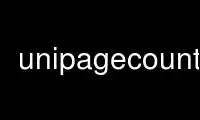
This is the command unipagecount that can be run in the OnWorks free hosting provider using one of our multiple free online workstations such as Ubuntu Online, Fedora Online, Windows online emulator or MAC OS online emulator
PROGRAM:
NAME
unipagecount - Count the assigned code points in a GNU Unifont .hex file
SYNOPSIS
unipagecount [-ppagenum] [-h|-l]
DESCRIPTION
unipagecount reads a GNU Unifont .hex file from STDIN and prints a 16 by 16 grid of the
number of defined code points in each 256 character block within a Unicode plane to
STDOUT. Code points proceed from left to right, then top to bottom. In all planes, code
points U+*FFFE and U+*FFFF are not expected in the input hex file; they are reserved and
always counted as being present in a plane.
OPTIONS
-Pplanenum Select a Unicode plane, from 0 through 16, inclusive. If not specified,
unipagecount defaults to Plane 0 (the Basic Multilingual Plane).
-ppagenum Just print information on one 256 code point "page" rather than the entire
Basic Multilingual Plane. This prints a 16 by 16 table with an asterisk in
every code point that has an assigned glyph.
-h Print an HTML table with color-coded cell background colors instead of a plain
text table.
-l [The letter "l"]: Print hyperlinks to font bitmaps in the HTML table. To
create the bitmaps themselves, use the unihex2bmp program. The bitmaps are
assumed to be in the directory "bmp/".
Use unipagecount online using onworks.net services
